How much do fame and success affect life expectancy?
The case of winners and nominees of cinema academy award
DOI:
https://doi.org/10.22199/S07187475.2017.0001.00003Keywords:
Life expectancy, Success, FameAbstract
Life expectancy (LE) is an indicator of the quality of life that a group has, as it relates to its economic and social development.However, effects of fame and success on LE are difficult to assess. Objective: To analyze a group of celebrities, winners and nominees to the Cinema Academy Award. Method: The study included a population of 1310, from which 533 dead people in the categories of main and supporting actors and directors were selected. These 533 were contrasted with national population statistics of the United States from 1860 to 2016. Results: Both populations register similar causes of death; however, celebrities decrease their LE due to the excess of drug abuse and accidents in their life styles. Conclusion: Fame and the stress of keeping a high social status may decrease LE of those who adopt life styles with higher risks and social pressure.
Downloads
References
Academy Awards. (2015). Academy Awards Database - AMPAS. Recuperado el 10 de mayo de 2016, a partir de http://awardsdatabase.oscars.org/ampas_awards/BasicSearchInput.jsp
Anderson, R. N. (2001). Deaths: leading causes for 1999. National vital statistics reports : from the Centers for Disease Control and Prevention, National Center for Health Statistics, National Vital Statistics System, 49(11), 1–87. https://doi.org/3456pl/098-987
Bipolar Disorder Centers. (2016). How Does Fame Influence Drug Abuse? | Bipolar Disorder Centers | Call 1-888-371-5714. Recuperado a partir de http://www.bipolardisorderscenters.com/how-does-fame-influence-drug-abuse/
CDC, C. for D. C. and P. (1998). Leading Causes of Death, 1900-1998. Natl. Vital Stat. Rep., 48, 1–67.
CDC, C. for D. C. and P. (2015). Overdose Data1999-2014.
Coalition agaisnt Drug Abuse. (2016). Celebrities & Drug related Death. Recuperado el 5 de octubre de 2016, a partir de http://drugabuse.com/featured/celebrity-drug-death-memorial-wall/
Davies, G., Elison, S., Ward, J., & Laudet, A. (2015). The role of lifestyle in perpetuating substance use disorder: the Lifestyle Balance Model. Subst Abuse Treat Prev Policy, 10(1), 2. https://doi.org/10.1186/1747-597X-10-2
DuRant, R. H., Rickert, V. I., Ashworth, C.S., Newman, C., & Slavens, G. (1993). Educational Status and Active Life Expectancy among Older Blacks and Whites. New England Journal of Medicine, 329, 110–116.
Epstein, C. R., & Epstein, R. J. (2013). Death in The New York Times: the price of fame is a faster flame. QJM : monthly journal of the Association of Physicians, 106(6), 517–21.https://doi.org/10.1093/qjmed/hct077
GHO. (2015). GHO | By category | Life expectancy - Data by WHO region. Recuperado el 5 de mayo de 2016, a partir de http://apps.who.int/gho/data/view.main.690?lang=en
Han, X., Small, D. S., Foster, D. P., & Patel, V. (2011). The effect of winning an oscar award on survival: Correcting for healthy performer survivor bias with a rank preserving structural accelerated failure time model. Annals of Applied Statistics, 5(2 A), 746–772. https://doi.org/10.1214/10-AOAS424SUPPA
Hoyert, D. L. (2012). 75 Years of Mortality in the United States , 1935 – 2010.
IMDB. (2016). IMDb - Movies, TV and Celebrities - IMDb. Recuperado el 10 de mayo de 2016, a partir de http://www.imdb.com/?ref_=ft_hm
Layden, J., Carnes, B. A., Ph, D., Brody, J., Hayflick, L., Butler, R. N., … Ludwig, D. S. (2005). A Potential Decline in Life Expectancy in the United States in the 21st Century, 1138–1145.
M. Moreno-Smith, S. K. Lutgendorf, a. K. S. (2011). Impact of stress on cancer metastasis. Future Oncol., 6(12), 1863–1881. https://doi.org/10.2217/fon.10.142.Impact
Miniño, A. M., Arias, E., Kochanek, K. D., Murphy, S. L., & Smith, B. L. (2002). Deaths: final data for 2000. National vital statistics reports : from the Centers for Disease Control and Prevention, National Center for Health Statistics,
National Vital Statistics System, 50(15), 1–119. https://doi.org/May 8, 2013
National Center for Health Statistics. (2015). Health, United States, 2014: With Special Feature on Adults Aged 55-64.
NCHS, N. C. for H. S. (2001). NCHS Ageadjusted Death Rates for Selected Major Causes of Death United States 1900-2013.
New York times. (2016). Obituaries - The New York Times. Recuperado el 12 de noviembre de 2016, a partir de http://www.nytimes.com/section/obituaries
Newsday. (2016). Newsday Obituaries. Recuperado el 12 de noviembre de 2016, a partir de http://www.legacy.com/obituaries/newsday/
OMS. (2011). Estadísticas Sanitarias Mundiales. Ginebra.
OMS, centro de prensa. (2014). Las 10 causas principales de defunción en el mundo. World Heath Organization, 6–8.https://doi.org//entity/mediacentre/factsheets/fs310/es/index.html
Rablen, M. D., & Oswald, A. J. (2008). Mortality and immortality: The Nobel Prize as an experiment into the effect of status upon longevity. Journal of Health Economics, 27(6), 1462–1471. https://doi.org/10.1016/j.jhealeco.2008.06.001
Redelmeier, D. A., & Singh, S. M. (2001). Survival in academy award-winning actors and actresses. Annals of Internal Medicine, 134(10), 955–962. https://doi.org/10.7326/0003-4819-134-10-200105150-00009
Rudd, R. A., Aleshire, N., Zibbell, Jon, E., & Gladden, M. R. (2016). Increases in Drug and Opioid Overdose Deaths - United States, 2000-2014. MMWR. Morbidity and mortality weekly report, 64(50–51), 1377–1382. https://doi.org/10.15585/mmwr.mm6450a1
Sylvestre, M. P., Huszti, E., & Hanley, J. A. (2006). Do Oscar winners live longer than less successful peers? A reanalysis of the evidence. Annals of Internal Medicine, 145(5), 361–363. https://doi.org/10.7326/0003-4819-145-5-200609050-00009
Tosato, M., Zamboni, V., Ferrini, A., & Cesari, M. (2007). The aging process and potential interventions to extend life expectancy. Clinical interventions in aging, 2(3), 401–12. Recuperado a partir de http://www.pubmedcentral.nih.gov/articlerender.fcgi?artid=2685272&tool=pmcentrez&rendertype=abstract
WHO. (2014). World Health Statistics 2014. Recuperado el 30 de diciembre de 2015, a partir de http://www.who.int/mediacentre/news/releases/20
Downloads
Published
Issue
Section
License
Los autores continúan como propietarios de sus trabajos, y pueden volver a publicar sus artículos en otro medio sin tener que solicitar autorización, siempre y cuando indiquen que el trabajo fue publicado originariamente en Revista Salud & Sociedad (ISSNe:0718-7475).



_(1).png)





